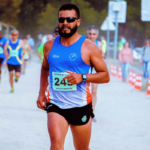Training for a half marathon is a significant but achievable challenge for beginners. The race covers a distance of 13.1 miles, or 21.1 kilometers, which may seem daunting at first. However, with the right approach, anyone can prepare themselves for this goal, regardless of their current fitness level. A half marathon represents a good balance between endurance and intensity, making it an ideal target for those looking to push their limits without committing to the even greater challenge of a full marathon.
How to train for a half marathon for beginners involves a structured plan that gradually builds up your stamina and strength. It’s essential to begin your preparation with realistic expectations and patience. A successful training plan incorporates not only running but also elements like nutrition, hydration, and rest. These components are crucial in helping you safely prepare for race day without risking injury or burnout.
Whether you are an experienced runner or completely new to the sport, understanding the distance and how to train for it is the first step in achieving success. The journey to running 13.1 miles will take time, effort, and commitment, but by breaking the task into manageable segments, you can confidently reach your goal. With a well-rounded plan in place, you will be ready to tackle the half marathon distance and cross the finish line on race day.
Evaluating Your Running Experience And Health Status
In case you are looking forward to commencing a half marathon training plan, the first thing you need to do is evaluate your fitness. Assessing your current fitness level is a crucial step since it will help you formulate realistic targets and assist in preventing injury. Every single runner at all levels including beginners, should evaluate their fitness levels as part of the preparation process.
Let’s start with some basics in relation to your personal running history. Ask questions such as how long have you been running, how frequently do you run, as well as what is the average distance that you run. However, if you are a novice, I wouldn’t worry much since everyone has to start from some place. But once you become a little more seasoned, you need to gauge whether you have been running on a regular basis and doing distance training or just short runs. This is necessary to understand the extent of the build up required.
Consulting with a doctor before taking on a strenuous training schedule is especially crucial if running is a new exercise for you. It’s ideal to check your general health right before starting. In case of having conditions like joint pain, heart problems, or even asthma, seeking professional advice will be essential. A physical check-up will help to sort out such issues beforehand and make sure that the individual is fit to cope with the training session.
Based on your current fitness and health status, you can now create a more tailored training plan that suits your needs. If you’re just starting out, you’ll need a more gradual approach, focusing on building up endurance without overexertion. If you’re already a runner, you may be able to dive into a more structured plan with higher intensity and longer distances. Either way, how to train for a half marathon for beginners involves making smart decisions based on where you’re starting from.
- Running experience: How long have you been running? Are you a beginner or have you been running for a while?
- Current weekly mileage: How many miles do you run each week on average?
- Health conditions: Do you have any existing injuries or health conditions, such as joint pain, asthma, or heart conditions?
- Fitness level: Are you able to comfortably run 3 miles without feeling too fatigued?
After completing this evaluation, you’ll be in a much better position to start a half marathon training plan. It will help you decide how much time you need to prepare and which elements to focus on first, ensuring that your journey to race day is safe, sustainable, and successful.
Developing A 12-Week Training Schedule
If you’re just starting out with a training plan for a half marathon, then lay a proper structure first. A 12-week plan is usually optimal to build sufficient endurance, strength and confidence while minimizing the risk of burnout or injury. The most important factor is to start slow by only concentrating on short runs which allows one to gradually increase mileage each week.
One of the key components in crafting a training plan is for the individual to recognize the need of consistency. Along with doing regular runs for cardiovascular endurance, there has to be sufficient energy recovery time. A good training plan has to enable a suitable mix of running, cross training and rest days. Low-impact forms of exercise like cycling or swimming do wonders in improving cardiovascular fitness while lessening stress on joints. These forms of exercise are also a good way to mentally relieve stress and prevent burn out.
One of the key components of a beginner’s half marathon training plan is to start with gradual mileage increases. In the early stages like the first 2 weeks, start with shorter runs around 2 to 4 miles. After the first month, begin adding a mile or two to your long runs to give your body time to adjust and become more conditioned. Long runs are fundamental to your training plan as they prepare you physically and mentally for race day.
Every week, it is crucial to have at least one long run. These runs are generally done on weekends when you have more time available. Shorter runs are typically included on the other days of the week so that you can also incorporate rest days. On the contrary, there is a misconception that rest days are inactive days. In fact, they are as important as any regular training day and more beneficial. Rest days allow sore or strained muscles to recover or heal and grow in strength. It is pivotal to the body and mind to schedule rest days into your training as neglecting it can lead to injuries and tiredness.
For cross training, try activities that cycle through different muscle groups, for instance, cycling or swimming. Such exercises are beneficial in increasing overall fitness because of the absence of strain running has on your joints. Increasing the amount of strength training in your routine will also increase muscle endurance, which is vital for your race. Strengthening the muscles in your legs and core will help you maintain good posture during the race and help prevent injury.
As the final weeks of your training plan commences, you should start tapering, which entails bringing down your running volume limit every week. This helps the body rest and recuperate for the race. It also gives your muscles adequate time to recover so that you are at peak fitness during the race.
By following a structured 12-week plan, you’ll be ready to take on the challenge of the half marathon. Understanding how to train for a half marathon for beginners ensures you develop a solid foundation, leading to a successful and enjoyable race experience.
Choosing The Right Running Shoes And Apparel
Choosing the proper equipment is necessary to ensure a pleasant experience while running a half marathon, as well as avoid injuries. The right type of shoes is important as it greatly affects your performance as well as guard you from injuries. When it comes to running, particular footwear is engineered to provide the necessary support, cushioning, and gentle protection. The precise matching of your shoes may be the difference that you need. Finally, proper apparel must also be selected, as breathable materials should be worn to reduce the risk of chafing and overheating.
When it comes to choosing running shoes, the focus should be on your feet, running style, and the environment – from the pavement, grass, or even a track base. Flat feet and high arches warrant the need for appropriately supportive shoes to minimize stress on the legs and feet. And, of course, the shoe must accommodate the running surface whether it’s pavement, a trail, or a track. Trail runners, for example, require more grip and protection for uneven surfaces.
Apart from shoes, clothing contributes greatly to the overall enjoyment of running. Look for inexpensive fabrics that can soak up moisture and sweat and are lightweight. This is crucial for long runs because the body produces a lot of heat. If shirts, shorts, and socks are made from these materials, they will be able to give you the comfort you need during a run and keep you dry and focused on working towards your next goal.
| Shoe Brand | Type | Best For | Key Features | Price Range |
| Nike | Neutral | Road running | Cushioned sole, breathable mesh | $100-$150 |
| Asics | Stability | Overpronation | Arch support, durable outsole | $90-$130 |
| Brooks | Cushioned | Long-distance running | Soft cushioning, shock absorption | $120-$160 |
| Salomon | Trail Running | Trail running | Aggressive tread, waterproof | $110-$180 |
Once you’ve chosen the right shoes, it’s time to focus on other gear such as socks and accessories. Invest in high-quality socks made of moisture-wicking material to avoid blisters. You should also consider wearing a running watch to track your pace, distance, and time. As for outerwear, a lightweight, reflective jacket is a good choice if you’re running in early mornings or late evenings, ensuring visibility and safety.
Fueling Your Body For Optimal Performance
Nutritional principles and hydration complement each other. Proper filling of the body is likely to improve endurance and facilitate better recovery. Eating alone is not enough, however. It’s equally important to keep hydrated and properly nourished. An understanding of how to properly fill one’s body is essential for any particular training or exercise.
A Balanced Diet is the cornerstone of good nutrition. Body fuels in the form of carbohydrates, proteins, and fats will all be beneficial and facilitate recovery. Lack of physical energy among runners is largely attributed to carbohydrates energy which is accumulated in muscles and the liver as glycogen. Runners should consume whole grains, fruits, and vegetables, which are rich in complex carbohydrates. Apart from carbs, athletes should equally focus on proteins. Chicken, fish, beans, and eggs are sources of lean protein which a person will need after exercising to repair damaged muscles. Avocados, nuts, and olive oil are examples of healthy fats which assist in maintaining hormone balance for health.
How to train for a half marathon for beginners involves not only building mileage but also understanding the nutrition that supports your training. Timing your meals and snacks around your runs is also crucial. Eating a carbohydrate-rich meal about 3-4 hours before a run can give you the energy you need for a successful workout. For shorter runs, a small snack like a banana or energy bar can help fuel your workout. After running, focus on replenishing your body with a combination of protein and carbohydrates to kickstart muscle repair and refuel your energy stores.
Hydration is another critical aspect of training. Staying hydrated before, during, and after your runs helps prevent dehydration, which can impair your performance and recovery. Aim to drink water throughout the day and consume additional fluids during runs that last longer than 45 minutes. Sports drinks or electrolyte supplements can be useful for longer training sessions, as they replace electrolytes lost through sweat and provide quick energy.
Proper nutrition and hydration are integral to maintaining the energy you need to successfully complete each training session and, ultimately, the race. By following these fueling strategies, you can maximize your training results and enhance your performance on race day.
Incorporating Rest And Injury Prevention Techniques
In half marathon training plans, the rest components and injury prevention are some of the most commonly neglected parts of the half marathon training plan. However, rest and recovery are as vital as undertaking the runs. Muscles, joints, and the cardiovascular system are under considerable stress when training for races, particularly half marathons. This can lead to injuries that may set back an individual completely if adequate resting and precautionary measures are not taken. With such competitive races, it becomes even more important to adopt practices that help recover as well as reduce the chances of injury, ultimately ensuring a healthy working body.
Central to the notion of injury prevention rests the more valuable principle of paying attention to the signals your body sends you. Any and all sensations of pain, discomfort or any such abnormal feelings must be addressed forthwith. Considered overuse injuries, such as shin splints, stress fractures, and runner’s knee are some of the most common problems faced by long-distance runners. These injuries surface as a result of excessive force being applied on the body within a limited recovery phase.
Rest Days are indispensable in avoiding injuries of this nature. You ought to integrate rest days when building up your training timetable. It is advisable to refrain from heavy exercising and allow muscles to recover during these rest days. However, you can engage in active recovery. Gentle activities like yoga, swimming, or walking can aid in circulation and enable your muscles to relax while aiding in recovery.
So as to minimize the possibility of getting hurt, here are other strategies during training that can help with injury prevention:
- Stretch regularly before and after your runs to improve flexibility.
- Incorporate strength training exercises, particularly for your core and legs, to improve stability and reduce the risk of injuries.
- Use proper running form to minimize strain on your joints.
- Wear appropriate footwear that provides support and cushioning.
- Avoid increasing your mileage too quickly; aim for a 10% increase in your weekly mileage to allow for gradual adaptation.
By following these strategies, you reduce the strain on your body and help prevent common running injuries. However, it’s important to remember that rest is just as vital as training. Without enough rest, your body can’t repair itself and become stronger. Additionally, proper recovery techniques such as foam rolling, ice baths, and massages can further aid in muscle repair and help alleviate soreness.
Proper rest and injury prevention will help ensure that you are physically prepared for the demands of a half marathon. Taking care of your body now will allow you to continue training effectively and reduce the risk of burnout or injuries.
Preparing For Race Day And Final Preparation
Preparing for your race is one of the most crucial aspects of the last few weeks of your half marathon training. For this reason, use this time to concentrate on your current fitness while also permitting your body to relax and recuperate. It is also very important in the last few weeks that you avoid over training, which could cause over-exertion or injuries. Lowering your mileage while allowing your body to mend and recharge its energy can help, as can a tapering approach. This will help guarantee that come race day, you will be at optimal strength.
It is equally important to manage your expectations and psyche while also readying for the race itself. There are many forms of visualization that you can use to increase your confidence, including mapping out the race and breathing exercises for pacing. Also think of practical issues on race day like how to reach the starting point, what to have before the race, and how to distribute your effort over the race. When implemented, forward thinking assists with effectively managing focus and stress.
As race day approaches, keep in mind the key elements of how to train for a half marathon for beginners, like pacing, fueling, and hydration. These are the cornerstones of race-day success and will help you complete the half marathon feeling accomplished and proud.






